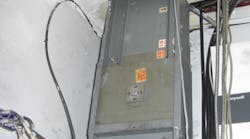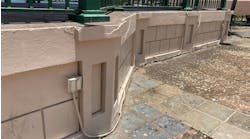How well do you know the Code? Think you can spot violations the original installer either ignored or couldn't identify? Here's your chance to moonlight as an electrical inspector and second-guess someone else's work from the safety of your living room or office. Joe Tedesco, who has a knack for finding shoddy electrical work, did the dirty work and found this mess. Now it's your turn to identify the violation.
Find the Answer
As defined in 368.2 of the 2008 NEC, a busway is “a grounded metal enclosure containing factory-mounted, bare or insulated conductors, which are usually copper or aluminum bars, rods, or tubes.”
The installation requirements for busways can be found in Sec. 368.10. ”Busways shall be permitted to be installed where they are located in accordance with 368.10(A) through (C).”
The installation requirements for installing busway through walls and floors can be found in 368.10(C), which states:
“Busways shall be permitted to be installed through walls or floors in accordance with (C)(1) and (C)(2).”
- ”(1) Walls. Unbroken lengths of busway shall be permitted to be extended through dry walls.”
-
”(2) Floors. Floor penetrations shall comply with (a) and (b):
“(a) Busways shall be permitted to be extended vertically through dry floors if totally enclosed (unventilated) where passing through and for a minimum distance of 1.8 m (6 ft) above the floor to provide adequate protection from physical damage.”
”(b) In other than industrial establishments, where a vertical riser penetrates two or more dry floors, a minimum 100-mm (4-in.) high curb shall be installed around all floor openings for riser busways to prevent liquids from entering the opening. The curb shall be installed within 300 mm (12 in.) of the floor opening. Electrical equipment shall be located so that it will not be damaged by liquids that are retained by the curb.”
“FPN: See 300.21 for information concerning the spread of fire or products of combustion.”





